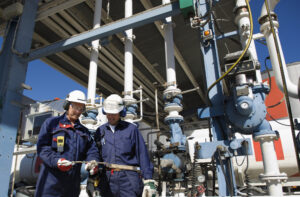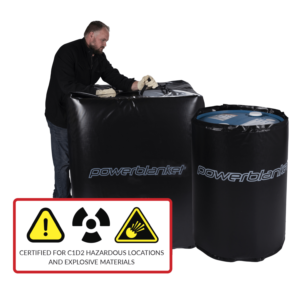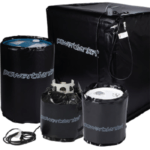The Importance of Safe Heating Equipment in Industrial Settings
In industrial settings, heating equipment is critical to many processes, from manufacturing to food production. However, this equipment can also be hazardous, leading to explosions that can cause severe injury or even death. Explosion-proof heating equipment is designed to prevent these risks, and industrial operators need to understand what this term means and how to select and maintain safe equipment. So what does explosion-proof mean for equipment or heaters in these higher-risk hazardous locations?
What Does Explosion-Proof Mean?
Explosion-proof heating equipment is designed to prevent these risks. This type of equipment is constructed to contain any potential explosion inside the device and prevent the ignition of flammable materials outside. The explosion-proof concept relies on specialized engineering, materials, and safety features that reduce the risks of ignition and pressure buildup.
Understanding the Risks
The risks of uncontrolled heating equipment are significant. Flammable gases, vapors, or dust can ignite, leading to explosions. This can happen when heat sources, such as heating elements or furnaces, ignite these substances or overheating causes a pressure buildup. These risks are especially high in industrial settings where flammable materials are present, such as chemical plants, oil refineries, or food processing facilities.
In industrial settings, the risks associated with uncontrolled heating equipment can be significant, particularly in hazardous locations where flammable gases, vapors, or dust are present. Explosions can occur due to ignition sources such as internal sparks, overheating, or surface temperatures that are hot enough to ignite vapors or gases in the air surrounding the equipment. These explosions can cause significant damage, including injury or death to workers and facilities.
To prevent explosions in hazardous environments, explosion-proof products are designed to prevent sparks and internal explosions from occurring. Explosion-proof means that the equipment is designed to contain any internal explosion, preventing an exterior explosion from occurring. Explosion-proof products are tested and certified by a testing laboratory to ensure that they meet specific safety standards, such as those outlined in the National Electric Code.
In addition to explosion-proof products, intrinsically safe equipment is also used in hazardous locations. Intrinsically safe equipment is designed to prevent explosive gases from igniting by limiting the amount of electrical energy that the equipment can generate. This limits the amount of heat generated and prevents ignition sources from occurring.
To prevent explosions, it’s essential to ensure that all heating equipment is designed for use in hazardous locations and complies with applicable regulations. This includes selecting equipment that is certified for use in hazardous locations and installing it in a way that ensures it is safe for use. Regular inspections and maintenance are critical to ensure that equipment continues operating safely and does not pose an explosion hazard.
Understanding the risks associated with uncontrolled heating equipment and taking steps to prevent explosions is essential in hazardous environments. Explosion-proof and intrinsically safe equipment can help prevent sparks and internal explosions, limiting the potential for damage and injury. By following applicable regulations, selecting appropriate equipment, and conducting regular maintenance and inspections, industrial operators can help ensure that their facilities are safe and free from the risk of explosion.
How Explosion-Proof Products Work
Explosion-proof heating equipment is designed to operate safely in hazardous environments by using specific safety measures such as encapsulation, flame arrestors, and pressure relief devices. These safety features are carefully engineered to contain any potential explosion and prevent it from spreading to other areas. Additionally, explosion-proof heating equipment must be grounded to prevent static electricity buildup that could ignite flammable materials.
Different Types of Explosion Proof Heating Equipment
Several types of explosion-proof heating equipment are available, each designed for specific industrial applications. Examples include immersion heaters, circulation heaters, duct heaters, and infrared heaters. It’s crucial to select the right equipment for the specific industrial setting to ensure that safety measures are adequate and appropriate.
Selecting the Right Explosion Proof Heating Equipment
Selecting the right explosion-proof heating equipment is critical for ensuring the safety of workers and preventing hazardous incidents in industrial settings. Here at Powerblanket, we provide top-of-the-line heating equipment for any hazardous environment. Our explosion-proof heating equipment is designed to meet the highest standards and is suitable for use in hazardous environments such as chemical plants, oil refineries, or food processing facilities. We have ready-to-ship products, like our drum and tote heaters, for hazardous locations, or we have a team ready to help you with our custom hazardous location heating solutions.
When working with Powerblanket, customers can trust that they will receive equipment that is designed to meet specific requirements for the nature of the industrial process, the type of materials being heated, and hazardous area classification. Our heating equipment is available in various styles, including immersion, circulation, and drum heaters, each designed for specific industrial applications.
In addition to providing high-quality heating equipment, we offer expert guidance to help customers select the right equipment for their needs. Our team of experts can assist in balancing safety concerns with other factors, such as cost and performance, ensuring that customers receive equipment that meets their needs while prioritizing safety.
Our explosion-proof heating equipment is designed to meet and exceed regulatory standards, including those set forth by the National Fire Protection Association (NFPA).
Meeting Industrial Explosion-Proof Rating Safety Standards
The National Fire Protection Association (NFPA) is an organization that develops and publishes codes and standards for fire safety and prevention in various settings, including industrial settings where hazardous materials are present. These codes and standards include requirements for explosion-proof products to ensure safe operation in environments where explosive atmospheres can occur.
The NFPA publishes various standards related to explosion-proof equipment, including NFPA 70, the National Electrical Code (NEC), which specifies the electrical installation requirements for explosion-proof equipment, and NFPA 496, Standard for Purged and Pressurized Enclosures for Electrical Equipment, which provides requirements for electrical equipment that is enclosed in a purged and pressurized housing to prevent the accumulation of flammable gases, vapors, or dust.
In addition to these standards, the NFPA also provides guidance on the selection, installation, and maintenance of explosion-proof equipment. This guidance is based on best practices and industry expertise and is intended to help industrial operators ensure that their equipment is safe and compliant with applicable regulations.
Overall, the NFPA plays an important role in ensuring that explosion-proof equipment meets safety requirements and operates safely in hazardous industrial settings. By following NFPA codes and standards, industrial operators can help prevent explosions and ensure the safety of their employees and facilities. Depending on your specific location needs, you might want to explore more deeply the difference between C1D1 and C1D2 or other considerations.
| Explosion-Proof Class | Division | Definition |
|---|---|---|
| Class I | Division 1 | Locations where flammable gases, vapors, or liquids are present in sufficient quantities to create an explosion hazard under normal operating conditions. |
| Class I | Division 2 | Locations where flammable gases, vapors, or liquids are present but are normally confined and would only pose an explosion hazard under abnormal conditions. |
| Class II | Division 1 | Locations where combustible dust is present in sufficient quantities to create an explosion hazard under normal operating conditions. |
| Class II | Division 2 | Locations where combustible dust is present but is normally confined and would only pose an explosion hazard under abnormal conditions. |
| Class III | Division 1 | Locations where easily ignitable fibers or flyings are present in sufficient quantities to create an explosion hazard under normal operating conditions. |
| Class III | Division 2 | Locations where easily ignitable fibers or flyings are present but are normally confined and would only pose an explosion hazard under abnormal conditions. |
Installation and Maintenance
Proper installation and ongoing maintenance are critical to ensure explosion-proof heating equipment operates safely. This includes following the manufacturer’s instructions carefully, conducting regular inspections, and repairing or replacing damaged equipment promptly. Following established best practices is essential to ensure safe installation and maintenance.
We Assist You in Meeting Strict Standards
Selecting the right explosion-proof heating equipment is critical for ensuring the safety of workers and preventing hazardous incidents in industrial settings. We provide top-of-the-line heating equipment that meets the highest explosion-proof standards and is suitable for use in various hazardous environments. By working with our team of experts, customers can ensure they receive equipment that meets their specific needs while prioritizing safety.
Explosion-proof heating equipment is a crucial aspect of industrial safety, and it’s essential to understand what this term means and how to select and maintain safe equipment. With the right equipment and proper installation and maintenance, industrial operators can ensure their heating equipment operates safely and efficiently, reducing the risks of hazardous incidents that could cause harm to employees and damage to the facility. Safety should always be prioritized for those working in industrial settings.
Keep your equipment running smoothly and prevent damage with Powerblanket's advanced hazardous location heating systems.







